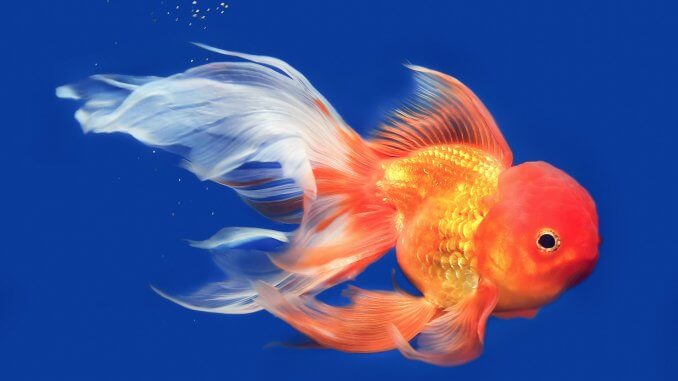
Goldfish are a true aquarium classic and are often the first choice for beginner fishkeepers.
When most people think of goldfish, they think of the typical bright orange and yellow varieties, but these fish come in many different shapes, sizes, and colors.
With more than 25 varieties to choose from, there is one for every fishkeeper.
TABLE OF CONTENTS
Single-Tailed vs Double-Tailed Goldfish
Goldfish are typically divided into two groups based on their physical features: single-tailed and doubled-tailed.
Singled-tailed goldfish have a single caudal and anal fin. These goldfish are usually what you picture when you think of goldfish. They have long, streamlined bodies and short, singular tails.
Double-tailed goldfish, also commonly referred to as fancy goldfish, have double caudal and anals fins. They also tend to have exaggerated features such as egg-shaped bodies, bubble eyes, headgrowths, or humps.
Fancy goldfish are typically rarer and more expensive than single-tailed goldfish. They are also more difficult to keep, due to their tank requirements and proneness to infection.
Single-Tailed Goldfish Types
The single-tailed breeds include the standard forms well known to all aquarists. They have long, slim bodies with a single caudal fin and two sets of pectoral and anal fins.
In the wild, they are native to China. However, their popularity has led to their introduction in waters all over the world.
Common Goldfish
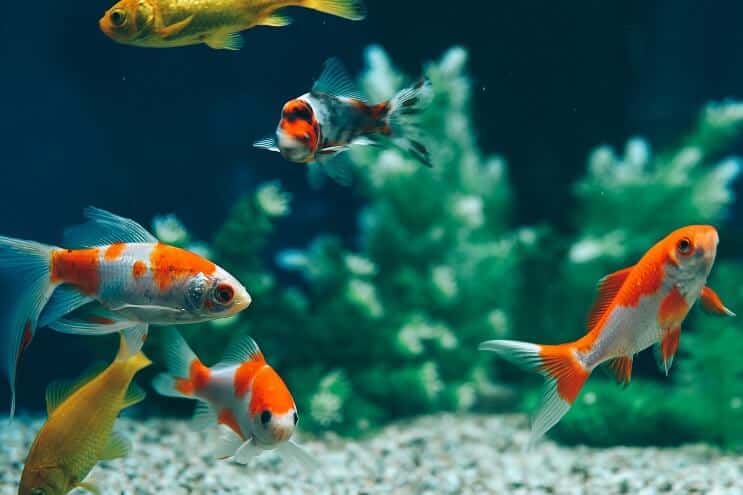
The common goldfish is the standard variety that you will find at most pet shops and aquarium suppliers.
Their iconic golden colors are exclusive to captive fish. In the wild, these fish are often silver or dull bronze. They can be found in various colors beyond standard gold including red, orange, white, and yellow. Mottled and calico versions are also very popular.
Common goldfish can grow up to six inches long in a tank, but in a garden pond, they can reach lengths of ten inches or more.
Contrary to popular belief, they should never be kept in a bowl.
Another popular misconception is that common goldfish have very short memories. In reality, they can retain information for up to three months at a time.
Common goldfish can also be used and sold as feeder goldfish.
Comet Goldfish
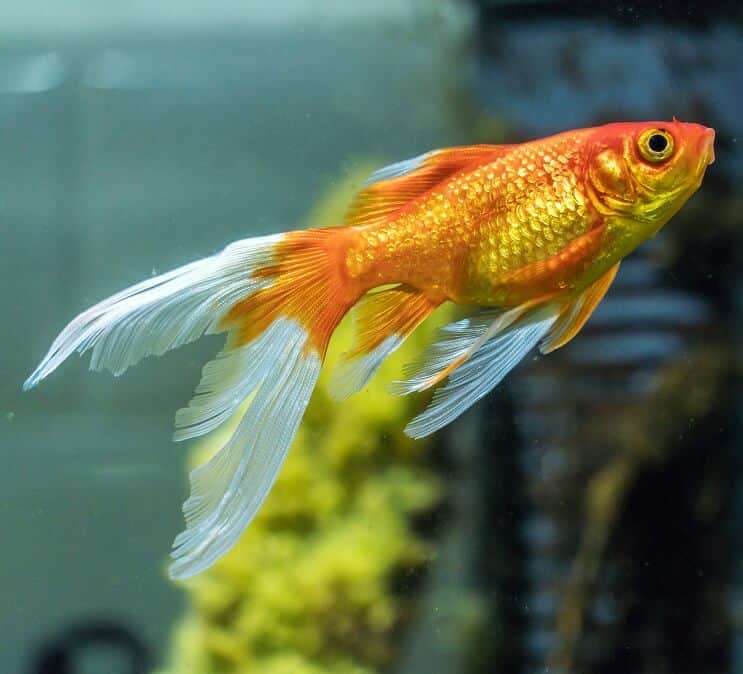
The comet goldfish is one of the most popular varieties of single-tailed goldfish. The breed originated in the United States in the 1880s.
These fish have long, slim bodies with trailing tails, which is how they got their name. Comet goldfish are typically orange or yellow but can come in other color forms as well.
Their trailing fins and smaller size are what distinguish them from the common goldfish.
Comets are very fast swimmers that do better in garden ponds than indoor tanks. Give them the space to swim, and they will display their grace and coordination.
Like common goldfish, comets are one of the most common varieties of feeder goldfish.
Rainbow Goldfish
Rainbow goldfish is a name given to white-scaled goldfish that may appear iridescent under certain lights. The whiter the color and the larger the scales, the more colors will be reflected.
Calico goldfish can also be called rainbow if they display a particularly large array of colors.
If you are looking for a rainbow goldfish for your tank or pond, consider either one of these fish.
Shubunkin Goldfish
The shubunkin goldfish is very similar to the comet goldfish but has a calico pattern rather than a solid color.
Shubunkin goldfish have slim bodies with long, trailing tails. They are easy to care for and look brilliant in home aquariums due to their unique coloration.
Multiple varieties of the shubunkin exist including the:
- Blue shubunkin
- London shubunkin
- Bristol shubunkin
- American shubunkin
Koi Goldfish
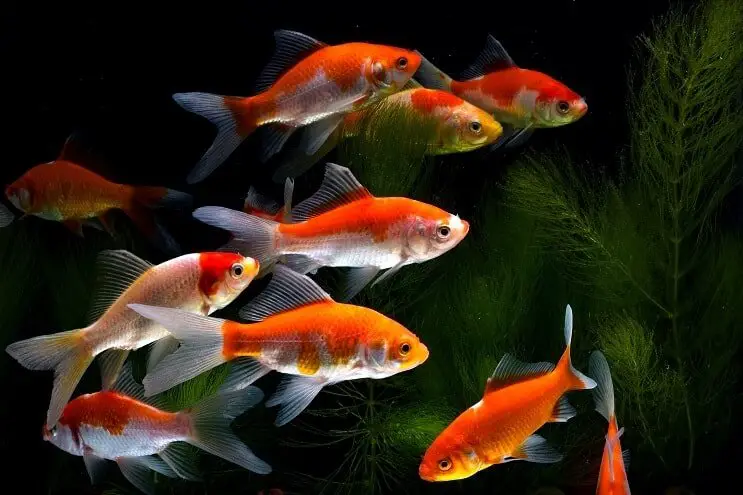
The name koi goldfish refers to ornamental breeds of the common carp.
Koi goldfish have white or silver scales, with red or orange spots and black markings.
Larger shubunkins and the Sarasa variety of comet goldfish can closely resemble koi. These varieties of goldfish serve as good koi substitutes for ponds on a budget.
Blue Goldfish
Blue is a highly valued color in the fishkeeping community. While there is no singular blue goldfish species, some species of goldfish can exhibit blue coloration.
It is quite uncommon and only available on scaleless varieties and certain fancy breeds.
Most calico fish have a blue or lavender base color.
Telescope goldfish and orandas can be bred for blue coloration. The value of the fish increases with the depth of the blue color.
Orange Goldfish

This is the single most well-known color. Shades of it vary from golden yellow to deep red. The value of the fish increases with the intensity of the color.
The orange color is a product of selective breeding for the aquarium trade. If an orange Goldfish is found in the wild, you can tell that it’s been released very recently.
Over time, feral fish released into the wild will revert to their natural colors and look more like the Common Carp.
Scaleless Goldfish
Usually, goldfish have beautiful iridescent scales everywhere however, scaleless varieties do exist.
Scaleless varieties of goldfish are not actually scaleless, their scales are just so small and thin that the fish appears scaleless when you look at it.
These fish can be white, red, gold, or even blue and purple. Their colors are much more intense than those of the scaled varieties and develop at 6–8 weeks old.
Black Goldfish
On the opposite end of the spectrum is a black or melanistic specimen of goldfish. This occurs when there is an excess of cells that produce dark pigments. Melanistic animals are black or very dark brown and are the result of a genetic mutation.
Completely black fish can also be selected for inbreeding.
Black is a very popular color for telescope goldfish, and orandas can also be bred for their deep black color.
Outside of these breeds, the black color is usually a random genetic occurrence just like albinism.
Calico Goldfish
A calico or mottled color is highly prized in the aquarium. For single-tailed goldfish, the most well-known example is the shubunkin.
They most often have blue or silver-based scales. The deeper and more vivid the blue color, the more expensive they are.
The ideal calico color form has deep blue, red, or white base scales with a sprinkling of black pepper spots all over the fish. It takes two to three years for the colors and patterns to fully develop.
This color is available in both single-tailed and double-tailed fancy varieties.
Albino Goldfish
Albinism is a lack of pigmentation and occurs when the fish lacks the cells that produce darker pigments.
In most cases, albinism occurs as the result of a recessive gene. It can occur in almost all breeds of single and double-tailed fish.
Albino fish are cream-colored with stark-white fins and very light pink or red eyes.
Double-Tailed (Fancy) Goldfish Types
The breeding and cultivation of fancy goldfish originated in Asia in the 19th century.
Most fancy breeds are distinguished from the common varieties by their paired caudal fins. In many cases, the anal fins and caudal fins have merged into a single pair of fins.
Ornamental fish have cultural significance in both Asia and the West and are even the subject of mythology and artworks.
Some breeds are considered sacred or regarded as status symbols.
The selective breeding of goldfish has resulted in a very wide variety of interesting colors and physical characteristics.
Fantail Goldfish
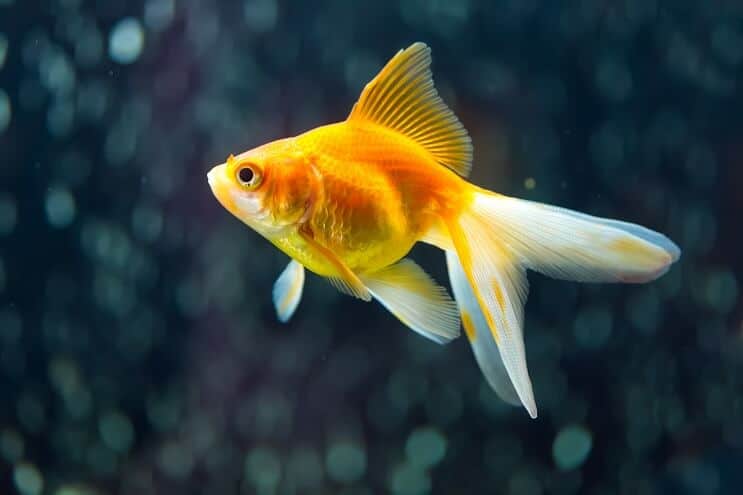
The fantail goldfish is the ideal breed for those selecting their very first fancy fish. Their body form is similar to that of the common goldfish but features a unique quadruple caudal fin.
They are named for their long, fan-shaped caudal fins and are usually white with orange, red, or gold markings.
Their quadruple fin is the result of merging between their paired anal and caudal fins.
Like the common goldfish, fantail goldfish can grow up to 12 inches in backyard garden ponds, but in an aquarium, they will grow to about six inches.
Telescope Eye Goldfish
Telescope goldfish are one of the most popular fancy breeds. They originated in China, but are now bred all over the world.
They are distinguished by their wide, protruding eyes. Their eyes can be round, cone-shaped, or tube-shaped.
These ‘telescope’ eyes can take anywhere from two months to two years to develop, but on average it takes three to five months.
The telescope goldfish has been bred for many different body forms and colors, but the typical variety resembles a veiltail goldfish with protruding eyes. They have wide dorsal fins and broad, trailing tails.
Fringetail and Ryukin Goldfish
The fringetail goldfish, or ryukin goldfish, is considered a Japanese version of the fantail.
This goldfish species has a round and slightly humped body, with a very high dorsal fin and long, trailing tails.
You can find fringetail goldfish in many of the color forms available to other breeds, including gold, white, and calico.
Oranda Goldfish
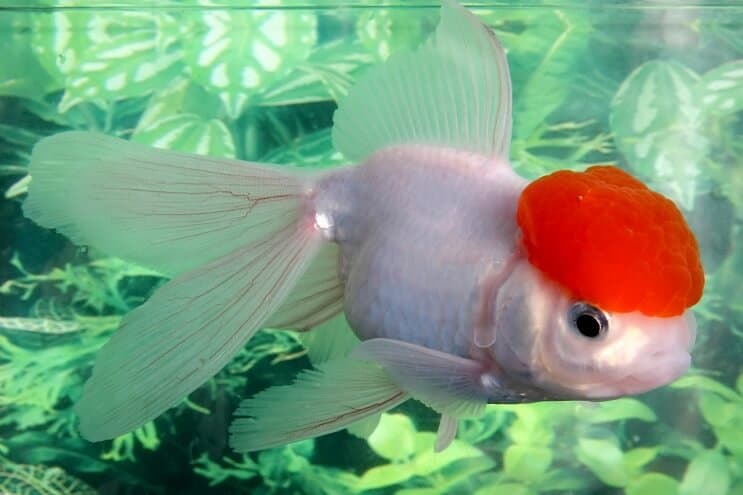
The oranda goldfish, also known as the redcap, is distinguished by the large hump on its head.
Oranda goldfish are similar to both the fantail and the lionhead. They may be a cross-breed of these two breeds, or simply a new variant of the fantail.
A popular color form features a white body with a red hood. The hood usually sits on top of its head but may cover the entire head as well.
Other color forms that exist include red, blue, and black.
Lionhead Goldfish
The lionhead goldfish is a Chinese goldfish with a humped head. It differs from the oranda in that it has short, stumpy fins and lacks a dorsal fin.
Its body is short and round, and the hood often covers its entire head.
The lionhead’s hood develops at six months of age and continues to grow as the fish grows. It may even extend to the gill plates and cause problems with respiration.
Lionheads can be red, white, or gold. They are also known as brambleheads because their hoods resemble clusters of berries.
Wakin Goldfish
The wakin goldfish is a fancy Japanese variant of the common foldfish, and is a very popular choice for outdoor garden ponds.
Wakin goldfish are distinguished as a fancy breed by their paired caudal andanal fins, and have the same long, slim bodies as single-tailed goldfish.
Wakins can grow to up to 16 inches long, and compliment koi and comets very nicely in an aquascaped tank or pond.
Pearlscale Goldfish
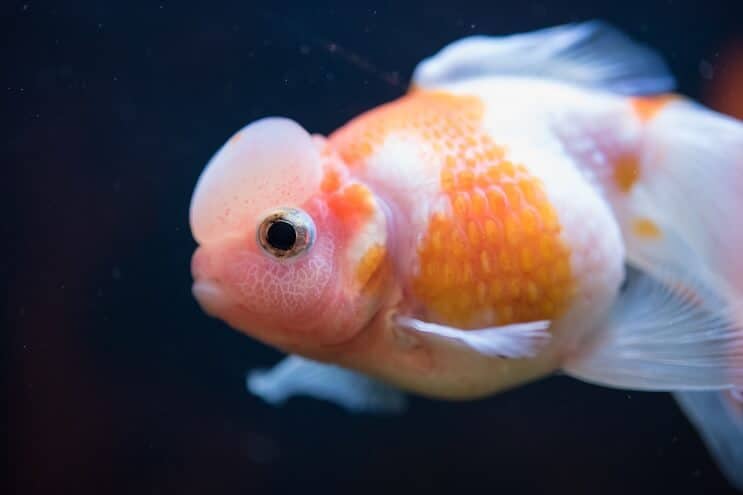
Pearlscale goldfish are one of the showiest fish you can find. They are popular because of their large, round scales that resemble jewels or pearls.
They have round bodies and short white fins.
These fish have dorsal fins but still face difficulty with balance and buoyancy due to their shape. They swim very slowly and may have a hard time holding themselves up in the water.
Bubble Eye Goldfish
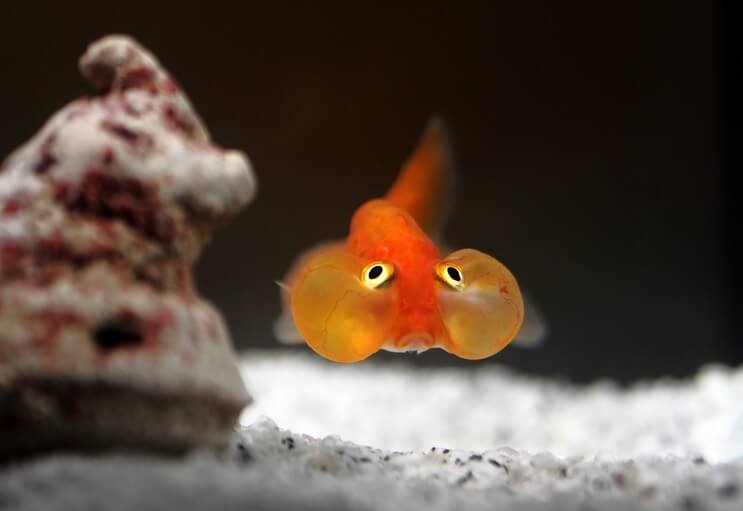
There are few goldfish breeds more controversial than the bubble eye. These fish originated in Asia and gained Western popularity during World War 2.
The defining characteristics of bubble eye goldfish are the fluid-filled sacs below their eyes. Larger sacs are highly prized, and thus these fish are deliberately bred to increase the sac size. These sacs cause extra vision problems for the fish, and unfortunately, blindness is a common issue in bubble eyes.
They often have a shortened lifespan compared to other breeds and can be difficult to breed and rear.
Black Moor Goldfish
The black moor goldfish is living proof that goldfish certainly don’t have to be gold! These fish are completely black except for their underbellies.
Usually, this color is the result of cross-breeding a deep red telescope goldfish with another black moor.
The color is highly sought after due to its attractive contrast to the aquarium waters. Black moor goldfish are slow and graceful swimmers, and have the same trailing fins as other telescope goldfish.
Other Fancy Goldfish Varieties
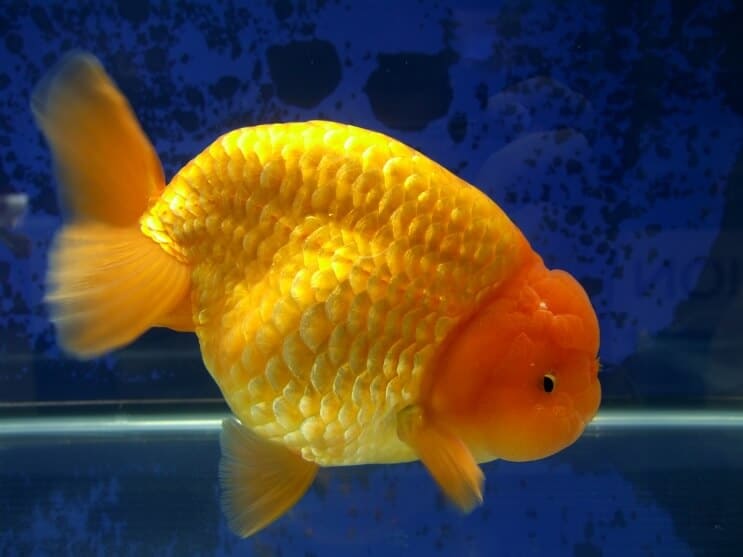
- Black oranda goldfish: These fish are deep black varieties of the oranda. They can be completely black or feature a bright red underbelly.
- Eggfish goldfish: The Chinese eggfish is a fringetail without a dorsal fin. It has a round, egg-shaped body and is usually white, but can also be red, gold, or mottled.
- Tiger goldfish: The tiger goldfish is also known as the piebald telescope. These fish have a banded tiger pattern, which can be partial or cover the entire body. The colors are usually red, orange, and black.
- Butterfly goldfish: These are some of the most elegant-looking fish around. This is a telescope goldfish that is bred for two large, fan-shaped tails that resemble a butterfly’s wings.
- Celestial goldfish: This is a telescope variant that features upward-pointing eyes, similar to the bubble eye. They have the body form of a regular telescope, though they lack a dorsal fin.
- Veiltail goldfish: The veiltail is an American variant of the fringetail. It has the same size and shape as the fringetail, but lacks the humped body and features an indent in the center of its tail.
- Izumo Nankin goldfish: The Izumo Nankin is a very rare breed that is similar to the eggfish and the ranchu. Most call them simply Nankin. Their ideal color form is red and white, with red extending to the caudal fin.
- Ranchu goldfish: The ranchu goldfish is a Japanese version of the lionhead, and can be gold, white, or feature a mottled color form.
- Jikin goldfish: This is a rare Japanese breed, that looks very similar to the wakin, but is small and oval-shaped. They are white with red or bright orange spots on their bodies, snouts, fins.
Which Goldfish Species Is Right for You?
While many of these breeds have very unique appearances, this should never be the top priority when you are selecting a goldfish for your aquarium.
When you are deciding on a goldfish variety, you should be sure you have the time and resources to dedicate to its specific needs.
Goldfish are still a classic, and with the right diet and tank setup, they can be a fantastic addition to your tank.

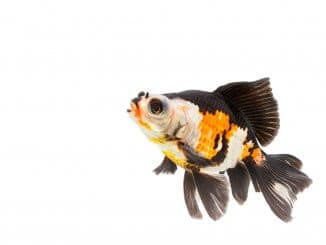
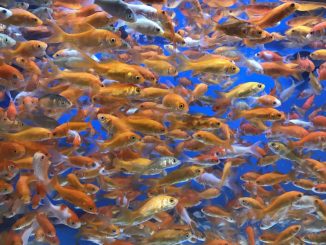

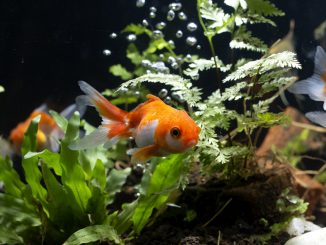
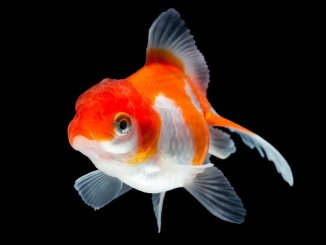
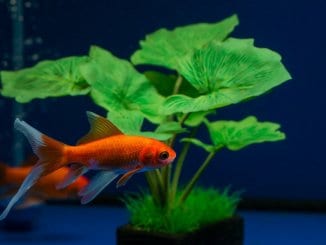

Be the first to comment